References
- ESR. Annual summary of outbreaks in New Zealand 2016 [Client Report FW17038]. Institute of Environmental Science and Research Ltd. (ESR). 2018. Available from: https://surv.esr.cri.nz/surveillance/annual_outbreak.php?we_objectID=4741.
- Lal A, Ikeda T, French N, et al. Climate variability, weather and enteric disease incidence in New Zealand: Time series analysis. PLoS One 2013;8(12). doi: 10.1371/journal.pone.0083484
- Britton E, Hales S, Venugopal K, et al. The impact of climate variability and change on cryptosporidiosis and giardiasis rates in New Zealand. Journal of Water and Health 2010;8(3):561. doi: 10.2166/wh.2010.049
- Lal A, Lill AWT, McIntyre M, et al. Environmental change and enteric zoonoses in New Zealand: a systematic review of the evidence. Australian and New Zealand Journal of Public Health 2015;39(1):63-68. doi: 10.1111/1753-6405.12274
- Lake IR, Pearce J, Savill M. The seasonality of human cryptosporidiosis in New Zealand. Epidemiology and Infection 2008;136(10):1383-1387. doi: 10.1017/S0950268807009922
- Davies CM, Ferguson CM, Kaucner C, et al. Dispersion and transport of Cryptosporidium oocysts from fecal pats under simulated rainfall events. Applied and Environmental Microbiology 2004;70(2):1151. doi: 10.1128/AEM.70.2.1151-1159.2004
- Davies-Colley R, Nagels J, Lydiard E. Stormflow-dominated loads of faecal pollution from an intensively dairy-farmed catchment. Water Science and Technology 2008;57(10):1519-23. doi: 10.2166/wst.2008.257
- Tryland I, Robertson L, Blankenberg A-G, et al. Impact of rainfall on microbial contamination of surface water. International Journal of Climate Change Strategies and Management 2011;3(4):361-73. doi: 10.1108/17568691111175650
- Lal A, Baker MG, Hales S, et al. Potential effects of global environmental changes on cryptosporidiosis and giardiasis transmission. Trends in Parasitology 2013;29:83-90. doi: 10.1016/j.pt.2012.10.005
- Lake IR, Bentham G, Kovats RS, et al. Effects of weather and river flow on cryptosporidiosis. Journal of Water and Health 2005;3(4):469-74. doi: 10.2166/wh.2005.048
- Curriero F, Patz J, Rose J, et al. The association between extreme precipitation and waterborn disease outbreaks in the United States, 1948-1994. American Journal of Public Health 2001;91(8):1194-9. doi: 10.2105/AJPH.91.8.1194
- Young I, Smith BA, Fazil A. A systematic review and meta-analysis of the effects of extreme weather events and other weather-related variables on Cryptosporidium and Giardia in fresh surface waters. Journal of Water and Health 2015;13(1):1-17. doi: 10.2166/wh.2014.079
- Duncanson M, Weinstein P, Chang W, et al. Cryptosporidiosis: Drinking water quality and other risk factors in Aotearoa New Zealand Epidemiology 2003;14(Supplement):S129-S30. doi: 10.1097/00001648-200309001-00318
- Coffey R, Bergin D, Cummins E. Use of meta-analysis to assess the effect of conventional water treatment methods on the prevalence of Cryptosporidium spp. in drinking water. Human and Ecological Risk Assessmen: An International Journal 2010;16(6):1360-78. doi: 10.1080/10807039.2010.526505
- Lal A. Evaluating the environmental and social determinants of enteric disease in New Zealand [Doctoral Thesis]. Department of Public Health, University of Otago, Wellington; 2014. Available from: https://ourarchive.otago.ac.nz/handle/10523/4813.
- Government reveals first changes to Resource Management Act. Radio New Zealand, 23 April 2024. Available from: https://www.rnz.co.nz/news/political/514993/government-reveals-first-changes-to-resource-management-act (accessed 30 April 2024).
- Grout L, Hales S, Baker MG, et al. Severe weather events and cryptosporidiosis in Aotearoa New Zealand: A case series of space-time clusters. Epidemiology and Infection 2024;152:e64. doi: 10.1017/S095026882400058X
- Gupta M, Haas CN. The Milwaukee Cryptosporidium outbreak: assessment of incubation time and daily attack rate. Journal of Water and Health 2004;2(2):59-69. doi: 10.2166/wh.2004.0006
- Jokipii L, Jokipii AMM. Timing of Symptoms and Oocyst Excretion in Human Cryptosporidiosis. The New England Journal of Medicine 1986;315(26):1643-47. doi: 10.1056/NEJM198612253152604
- Mac Kenzie WR, Schell WL, Blair KA, et al. Massive Outbreak of Waterborne Cryptosporidium Infection in Milwaukee, Wisconsin: Recurrence of Illness and Risk of Secondary Transmission. Clinical Infectious Diseases 1995;21(1):57-62. doi: 10.1093/clinids/21.1.57
- Horne S, Sibal B, Sibal N, et al. Cryptosporidium outbreaks: identification, diagnosis, and management. British Journal of General Practice 2017;67(662):425-26. doi: 10.3399/bjgp17X692501
- Olson ME, Goh J, Phillips M, et al. Giardia Cyst and Cryptosporidium Oocyst Survival in Water, Soil, and Cattle Feces. Journal of Environmental Quality 1999;28(6):1991-96. doi: 10.2134/jeq1999.00472425002800060040x
- Snel SJ, Baker MG, Kamalesh V, et al. A tale of two parasites: the comparative epidemiology of cryptosporidiosis and giardiasis. Epidemiology and Infection 2009;137(11):1641-50. doi: 10.1017/S0950268809002465
- Learmonth J, Ionas G, Pita A, et al. Seasonal shift in Cryptosporidium parvum transmission cycles in New Zealand. Journal of Eukaryotic Microbiology 2001:34S-35S.
- Grinberg A, Pomroy W, Weston J, et al. The occurrence of Cryptosporidium parvum, Campylobacter and Salmonella in newborn dairy calves in the Manawatu region of New Zealand. New Zealand Veterinary Journal 2005;53(5):315-20. doi: 10.1080/00480169.2005.36566
- Lawrence J, Mackey B, Chiew F, et al. Chapter 11: Australasia. In: Hoegh-Guldberg O, Wratt D, eds. IPCC WGII Sixth Assessment Report. Geneva: Intergovernmental Panel on Climate Change (IPCC), 2021.
- Fischer EM, Knutti R. Anthropogenic contribution to global occurrence of heavy-precipitation and high-temperature extremes. Nature Climate Change 2015;5(6):560-64. doi: 10.1038/nclimate2617
- McDaniel CJ, Cardwell DM, Moeller RB, et al. Humans and cattle: A review of bovine zoonoses. Vector Borne and Zoonotic Diseases 2014;14(1):1-19. doi: 10.1089/vbz.2012.1164
- Cavirani S. Cattle industry and zoonotic risk. Veterinary Research Communications 2008;32 (Suppl 1):S19-24. doi: 10.1007/s11259-008-9086-2
- Castro-Hermida JA, Garcia-Presedo I, Almeida A, et al. Detection of Cryptosporidium spp. and Giardia duodenalis in surface water: a health risk for humans and animals. Water Research 2009;43(17):4133-42. doi: 10.1016/j.watres.2009.06.020
- Queenstown cryptosporidium outbreak: Four more weeks of boiling water. Radio New Zealand, 14 November 2023. Available from: https://www.rnz.co.nz/news/national/502386/queenstown-cryptosporidium-outbreak-four-more-weeks-of-boiling-water (accessed 30 April 2024).
- Baker MG, Prickett M, Pourzand F, et al. Queenstown outbreak highlights future challenges for clean drinking water. The Briefing: Public Health Communication Centre Aotearoa, 29 September 2023.
- Gilpin BJ, Walker T, Paine S, et al. A large scale waterborne Campylobacteriosis outbreak, Havelock North, New Zealand. Journal of Infection 2020;81(3):390-95. doi: 10.1016/j.jinf.2020.06.065
- Government Inquiry into Havelock North Drinking Water. Report of the Havelock North Drinking Water Inquiry: Stage 2. Auckland, New Zealand, 2017.
About the Briefing
Public health expert commentary and analysis on the challenges facing Aotearoa New Zealand and evidence-based solutions.
Subscribe

Public Health Expert Briefing
Get the latest insights from the public health research community delivered straight to your inbox for free. Subscribe to stay up to date with the latest research, analysis and commentary from the Public Health Expert Briefing.

